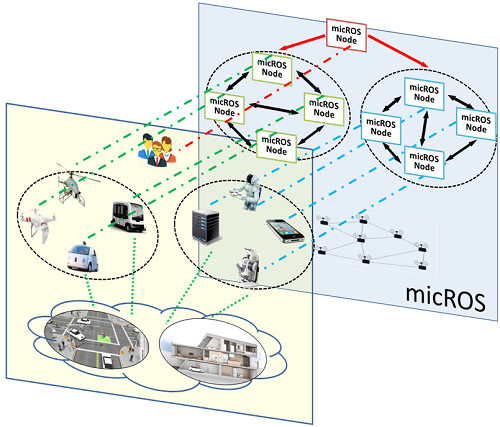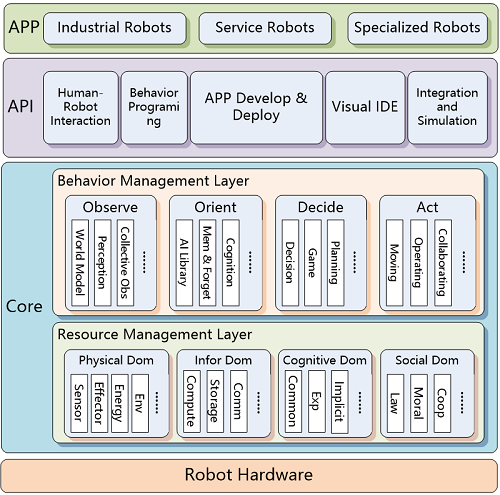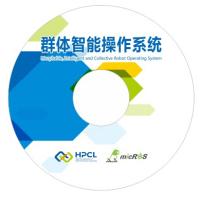Robots, as one of the most remarkable novel products in the Third Industrial Revolution, are developing in much the same way that Personal Computers did 40 years ago. The most important system software for robots, robot operating system, will be the key driving force for this trend. However, most of the current robot operating systems mainly focused on development of applications on individual robotic platform. The micROS Team aims to design and develop micROS, a Morphable, Intelligent and Collective Robot Operating System for future collective and collaborative robots.
Inspired by the organization structures of collective robots, we designed for micROS the overall distributed architecture which consists of lots of individuals (nodes) interconnected and the layered structure for each node which could be robots, computers or humans. Networking is the basis for constructing the distributed architecture and real-time is a distinguished feature of micROS.

Distributed architecture of micROS
micROS is installed on each node of the collective robots and has the layered structure for each node as shown in the figure below, which consists of the core layer and the API layer. The API layer is responsible for interaction and programming interface. The micROS core is divided into resource management layer and behavior management layer. The former is to manage the resources in physical domain, information domain, cognitive domain and social domain. The latter behavior management layer is made of observation, orientation, decision and action modules.

Layered structure for each micROS node
In order to implement the above-mentioned architecture and achieve efficient resource and behavior management for collective robots, we currently focus on the following research topics.
micROS v1.0.1 is an extended version based on micros v1.0.
micROS v1.0.1 contains main system functions in the file "micros" and additional functions in "Plugin" folder. Get micROS v1.0.1 now!
micROS v1.0 is the first official release of micROS. It is based on Ubuntu Kylin (优麒麟) 14.04 and ROS indigo. The organization of source code embodies our design of micROS architecture. Get micROS v1.0 now!
 |
|
Intorduction
In the proposed method, GPU-based SIFT features is used to realize real-time detection and matching between consecutive frames, their corresponding 3D points are optimized by comparing and fusing IMU data to improve odometry estimation stability, then keyframes are selected for incremental mapping, the graph optimization and moving least squares algorithm are applied to the dense reconstruction. To achieve a full 3D model of indoor environment, we realize the registration for over-lapped models by combining the features of key-frames and Simplified-ICP algorithm.
We plan to use the improved 3D SIFT feature points detection method, which combine with 3D RoPs feature descriptor to realize the estimation for the extrinsic parameters of over-lapped models, the K-Nearest Neighbor and Random Sample Consensus algorithms are used to optimize the accuracy of matched 3D feature points. We will make our code publicly available soon.
paper video code(coming soon...)
11. Yawei zhao, Deke Guo, Jia Xu, Pin Lv, Tao Chen, Jianping Yin, "Cooperative Allocation and Scheduling of Tasks for Minimizing Interval Data Sampling in WSNs", Accepted to appear at ACM Transactions on Sensor Networks (TOSN), 2016,12:(4).
10. Lailong Luo, Deke Guo, Jie Wu, Ori Rottenstreich, Qian He, Yudong Qing, Xueshan Luo. Efficient Multiset Synchronization. Accepted to appear at ACM/IEEE Transactions on Networking (TON), 2016.
9. Xiaoqiang Teng, Deke Guo, Xiaolei Zhou, Zhong Liu. Poster Abstract: An Indoor-Outdoor Navigation Service for Subway Transportation Systems. ACM Sensys 2015, Seoul, Korea.
8. Shangmin Wen, Bo Ding, Huaimin Wang, Ben Hu, and Peichang Shi. "Towards Migrating Resource-Consuming Robotic Software Packages to Cloud", IEEE International Conference on Real-time Computing and Robotics, Angkor Wat, Cambodia, June 6-10, 2016
7. Yiying Li, Huaimin Wang, Bo Ding, Peichang Shi, Xuan Liu. "Toward QoS-aware Cloud Robotic applications: A Hybrid Architecture and Its Implementation", IEEE International Conference on Ubiquitous Intelligence and Computing, Toulouse, France, July 18-21, 2016
6. Bo Ding, Huaimin Wang, Zedong Fan, Pengfei Zhang and Hui Liu. "MicROS-drt: supporting real-time and scalable data distribution in distributed robotic systems", Robotics and Biomimetics, 2016, 3(1):1-8
5. Minglong Li, Zhongxuan Cai, Xiaodong Yi, Zhiyuan Wang, Yanzhen Wang, and Yongjun Zhang, "ALLIANCE-ROS: A software architecture on ROS for fault-tolerant cooperative multi-robot systems", The 14th Pacific Rim International Conference on Artificial Intelligence (PRICAI 2016), Phuket, Thailand, August 22-26, 2016. (Accepted) [Project Page]
4. Yu Tian, Wanrong Huang, Yanzhen Wang, Xiaodong Yi, Zhiyuan Wang, and Xuejun Yang, "Multi-level occupancy grids for efficient representation of 3D indoor environments", The 14th Pacific Rim International Conference on Artificial Intelligence (PRICAI 2016), Phuket, Thailand, August 22-26, 2016. (Accepted) [Project Page]
3. Liu L, Lao S,
Pietikainen M, et al. ”Median robust extended local binary pattern for
texture classification” IEEE TRANSACTIONS ON IMAGE PROCESSING, VOL.
25, NO. 3, MARCH 2016 [PDF]
2. Dengqing Tang, Tianjiang Hu*, Lincheng Shen, Daibing Zhang, Weiwei Kong, and K. H. Low, "Ground stereo vision navigation for autonomous take-off and landing of UAV: a Chan-Vese model approach", Int. J. Advanced Robotic Systems, 13:0|DOI: 10.5772/62027, 2016.
1. Minglong Li, Xiaodong Yi, Yanzhen Wang, Zhongxuan Cai, and Yongjun Zhang, "Subsumption Model Implemented on ROS for Mobile Robots", The 10th Annual Systems Conference of IEEE (IEEE-SysCon 2016), Orlando, FL, USA, April 18-21, 2016. [PDF] [Project Page]
9. Kai Xu, Hui Huang, Yifei Shi, Hao Li, Pinxin Long, Jianong Caichen, Wei Sun, Baoquan Chen, "Autoscanning for coupled scene reconstruction and proactive object analysis", ACM Transactions on Graphics (SIGGRAPH Asia 2015), 34(6), 2015. [PDF] [Project Page]
8.Wang, R.,
Purshouse, R. C., Fleming, P. J., “Preference-inspired co-evolutionary algorithms
using weights for many objective optimisation ”, European Journal of Operational
Research, 243(2), 423-441, 2015 [PDF]
7. Guo S, Lao S,
Guo J, et al. “A Semi-automatic Solution
Archive for Cross-Cut Shredded Text Documents Reconstruction”Image and Graphics. Springer International
Publishing, 447-461. 2015 [PDF]
6. Boxin Zhao, O. Hellwich, Tianjiang Hu*, Dianle Zhou, Lincheng Shen, "Employing smartphone as on-board navigator in unmanned aerial vehicles: implementation and experiments", Industrial Robotics: An International Journal, 42(4): 306-313, 2015.
5. Bo Ding, Huaimin Wang, Zedong Fan, Pengfei Zhang, "micROS-drt: Supporting Real-time Data Distribution in Distributed Robot Software Systems", 2015 International Conference on Real-time Computing and Robotics (RCAR 2015), Changsha, Hunan, China, June 23-26, 2015.
4. Ruibin Guo, Dongxiang Zhou, Keju Peng, and Yunhui Liu, "3D Modeling of Indoor Environments Using Multiple Kinects", 2015 International Conference on Real-time Computing and Robotics (RCAR 2015), Changsha, Hunan, China, June 23-26, 2015. [PDF] [Project Page]
3. Xuefeng Chang, Yanzhen Wang, Xiaodong Yi, and Nong Xiao, "SARRT: a Structure-Aware RRT-based Approach for 2D Path Planning", 2015 IEEE Conference on Robotics and Biomimetics (IEEE-ROBIO 2015), Zhuhai, Guangdong, China, December 6-9, 2015. [PDF] [Project Page]
2. Shaowu Yang, Xiaodong Yi, Zhiyuan Wang, Yanzhen Wang, and Xuejun Yang, "Visual SLAM Using Multiple RGB-D Cameras", 2015 IEEE Conference on Robotics and Biomimetics (IEEE-ROBIO 2015), Zhuhai, Guangdong, China, December 6-9, 2015. [PDF] [Project Page]
1. Canben Yin, Shaowu Yang, Xiaodong Yi, Zhiyuan Wang, Yanzhen Wang, Bo Zhang, and Yuhua Tang, "Removing Dynamic 3D Objects from Point Clouds of a Moving RGB-D Camera", IEEE International Conference on Information and Automation (IEEE-ICIA 2015), Lijiang, Yunnan, China, August 8-10, 2015. [PDF] [Project Page]
https://github.com/cyberdb/micROS-cloud
MicROS-cloud is a cloud robotic platform which supports the direct deployment of ROS software packages onto the cloud. Basically, it can be regarded as a PAAS platform which adopts the ROS application model. A ROS package can be converted into a cloud service automatically. The robotic applications can access the cloud service remotely in an on-demand style through a WebSocket protocol.
The service access is purely based on a cloud service paradigm, which means that you need not concern ROS master and other configurations. Multiple robots can access a service simultaneously, for example, to build their own map respectively. The robotic applications which access the cloud services also need no modification, because Cloudrid can generate a stub ROS package with the same interface of the original ROS package, which acts as a local proxy of the remote cloud service.
By adopting the docker container technology in the back-end, a ROS package which is orignally designed for a single robot can serve multiple robots simultaneously by dynamically instantiation of the servant in the cloud. And by specifying the resource demand of the ROS package (e.g., mem, CPU, etc.), the quaility of a service can be assured by the internal mechanisms of MicROS-cloud.
Please contact us through siteen@outlook.com or bding@msn.com. Any feedback would be greatly appreciated.
v0.10 [2016-08-31]
This is an announcement for micros_swarm_framework, developed by Xuefeng, Yanzhen, and Xiaodong. It is a ROS-based programming framework for swarm robotics. Its goal is to facilitate ROS users in developing applications of robot swarms, by providing essential mechanisms, such as abstraction of swarms, swarm management, various communication tools, and a runtime environment, within the standard ROS ecosystem.
Documentation can be found on ROS Wiki: https://wiki.ros.org/micros_swarm_framework. Source code for the framework and demos in the Stage simulator can be found on GitHub: https://github.com/xuefengchang/micros_swarm_framework.